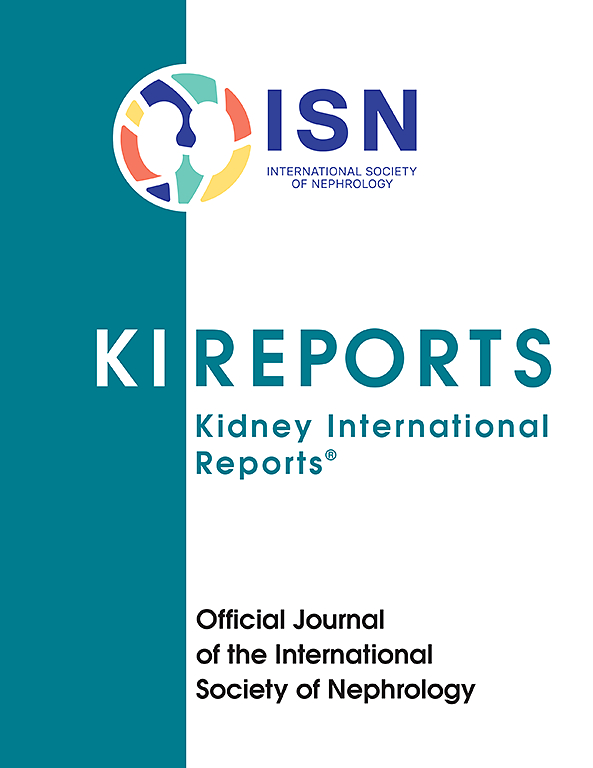改善诊断和治疗对整体CKD负担的影响
IF 5.7
2区 医学
Q1 UROLOGY & NEPHROLOGY
引用次数: 0
摘要
尽管有有效的干预措施,慢性肾脏疾病(CKD)是一种未被诊断和治疗的疾病。增加CKD患者的诊断和提高对指南导向药物治疗(GDMTs)的依从性的潜在临床、经济和环境影响尚不清楚。方法采用IMPACT CKD模型模拟8个国家人群(澳大利亚、巴西、中国、德国、荷兰、西班牙、英国和美国)25年,比较不同诊断和GDMT依从性情景下的负担与当前实践。GDMT包括保肾、降血糖、降脂、降压和生活方式干预。如果符合条件,患者可以接受一种或多种治疗,并且在一段时间内没有发生指南变化。假定治疗效果是倍增的。结果与目前的10年实践相比,改善GDMT依从性的方案预计透析、心血管(CV)事件和死亡的累积减少分别为- 3.2%至- 23.2%、- 12.2%至- 41.4%和- 2.3%至- 9.3%。由于CKD进展的延迟,肾脏替代疗法(KRT)的费用和环境负担预计也将分别下降- 2.5%至- 19.4%和- 2.7%至- 21.2%。所有的治疗方案都预测在25年内有更大的改善,强调了CKD的长期影响,并强调了早期干预的重要性。结论不同国家预测影响的差异是多因素的,尽管它们对人口和卫生保健系统很敏感。全球迫切需要实施政策,提高CKD的检测和治疗水平,以减轻CKD给患者和护理人员、卫生保健系统、社会和环境带来的日益增长的负担。本文章由计算机程序翻译,如有差异,请以英文原文为准。

Impact of Improved Diagnosis and Treatment on Holistic CKD Burden
Introduction
Chronic kidney disease (CKD) is an underdiagnosed and undertreated disease despite the availability of effective interventions. The potential clinical, economic, and environmental impacts of increased diagnosis and improved adherence to guideline-directed medical therapies (GDMTs) recommended for patients with CKD are not well-understood.
Methods
Eight country populations (Australia, Brazil, China, Germany, The Netherlands, Spain, UK, and USA) were simulated for 25 years using the IMPACT CKD model to compare burdens under various diagnosis and GDMT adherence scenarios versus current practice. GDMT consisted of kidney protecting, glucose lowering, lipid lowering, as well as antihypertensive and lifestyle interventions. Patients could be treated with 1 or multiple therapies, if eligible, and no guideline changes occurred over the time horizon. Treatment effects were assumed multiplicative.
Results
Scenarios with improved GDMT adherence projected cumulative decreases in dialysis, cardiovascular (CV) events, and death by −3.2% to −23.2%, −12.2% to −41.4%, and −2.3% to −9.3%, respectively, compared with current practice over 10 years. Because of delayed CKD progression, kidney replacement therapy (KRT) costs and environmental burden were also projected to decrease by −2.5% to −19.4% and −2.7% to −21.2%, respectively, compared with current practice. All treatment scenarios predicted greater improvements over 25 years, underscoring the long-term impact of CKD, and highlighting the importance of early intervention.
Conclusion
Differences in projected impacts between countries are multifactorial, though they are sensitive to demographics and health care systems. Implementation of policies that lead to improved detection and treatment of CKD are urgently required across the globe to mitigate the growing burdens of CKD on patients and caregivers, health care systems, society, and our environment.
求助全文
通过发布文献求助,成功后即可免费获取论文全文。
去求助
来源期刊

Kidney International Reports
Medicine-Nephrology
CiteScore
7.70
自引率
3.30%
发文量
1578
审稿时长
8 weeks
期刊介绍:
Kidney International Reports, an official journal of the International Society of Nephrology, is a peer-reviewed, open access journal devoted to the publication of leading research and developments related to kidney disease. With the primary aim of contributing to improved care of patients with kidney disease, the journal will publish original clinical and select translational articles and educational content related to the pathogenesis, evaluation and management of acute and chronic kidney disease, end stage renal disease (including transplantation), acid-base, fluid and electrolyte disturbances and hypertension. Of particular interest are submissions related to clinical trials, epidemiology, systematic reviews (including meta-analyses) and outcomes research. The journal will also provide a platform for wider dissemination of national and regional guidelines as well as consensus meeting reports.
 求助内容:
求助内容: 应助结果提醒方式:
应助结果提醒方式:


